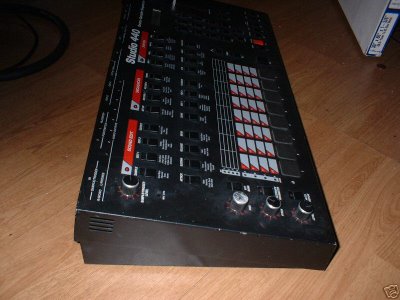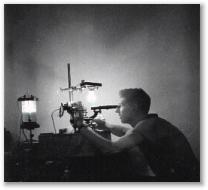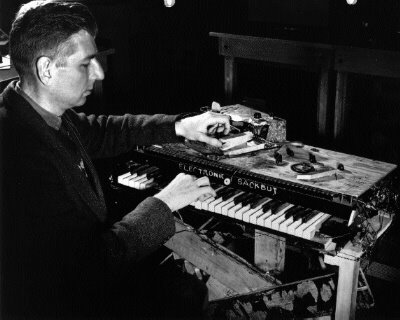Title link takes you to a bit of Buchla history.
Excerpt:
"In contrast to Moog's industrial stance, the rather counter-cultural design philosophy of DONALD BUCHLA and his voltage-controlled synthesizers can partially be attributed to the geographic locale and cultural circumstances of their genesis. In 1961 San Francisco was beginning to emerge as a major cultural center with several vanguard composers organizing concerts and other performance events. MORTON SUBOTNICK was starting his career in electronic music experimentation, as were PAULINE OLIVEROS, RAMON SENDER and TERRY RILEY. A primitive studio had been started at the San Francisco Conservatory of Music by Sender where he and Oliveros had begun a series of experimental music concerts. In 1962 this equipment and other resources from electronic surplus sources were pooled together by Sender and Subotnick to form the San Francisco Tape Music Center which was later moved to Mills College in 1966.
Because of the severe limitations of the equipment, Subotnick and Sender sought out the help of a competent engineer in 1962 to realize a design they had concocted for an optically based sound generating instrument. After a few failures at hiring an engineer they met DONALD BUCHLA who realized their design but subsequently convinced them that this was the wrong approach for solving their equipment needs. Their subsequent discussions resulted in the concept of a modular system. Subotnick describes their idea in the following terms:
'Our idea was to build the black box that would be a palette for composers in their homes. It would be their studio. The idea was to design it so that it was like an analog computer. It was not a musical instrument but it was modular...It was a collection of modules of voltage-controlled envelope generators and it had sequencers in it right off the bat...It was a collection of modules that you would put together. There were no two systems the same until CBS bought it...Our goal was that it should be under $400 for the entire instrument and we came every close. That's why the original instrument I fundraised for was under $500.'
Buchla's design approach differed markedly from Moog. Right from the start Buchla rejected the idea of a "synthesizer" and has resisted the word ever since. He never wanted to "synthesize" familiar sounds but rather emphasized new timbral possibilities. He stressed the complexity that could arise out of randomness and was intrigued with the design of new control devices other than the standard keyboard. pp39-40"
Anyone else thinking Starkey? Coincidentally the recent Starkey went for $541 on the bay. Yeah, I know I'm stretching it...
via Peter Grenader on AH.
Tuesday, August 22, 2006
Xpantastic ! - New Oberheim XPander Group
 It's XPantastic! Like the name? : ) Title link takes you to the new Yahoo! Group. If you have an XPander or Matrix-12 or are interested in them, feel free to join. I have no affiliation with the list. I just know the old Xpansions list seems to have dissapeared and somone created this one. BTW, if you know what happened to the Xpansions list, please comment. I think I'm subbed to it, but I'm no longer sure. : ) I haven't received an email in probably over a year, so... Not sure if I unsubbed and forgot or if it just died.
It's XPantastic! Like the name? : ) Title link takes you to the new Yahoo! Group. If you have an XPander or Matrix-12 or are interested in them, feel free to join. I have no affiliation with the list. I just know the old Xpansions list seems to have dissapeared and somone created this one. BTW, if you know what happened to the Xpansions list, please comment. I think I'm subbed to it, but I'm no longer sure. : ) I haven't received an email in probably over a year, so... Not sure if I unsubbed and forgot or if it just died.
Sequential Circuits Studio 440
 Title link takes you to shots pulled from this auction.
Title link takes you to shots pulled from this auction.Rare sampling drum machine with analog filters by Sequential Circuits. More on VSE.
via Matt
Secret of the Ancient Sampler on YouTube
Part 1 (audio comes it at 1:21)
Part 2
The Mellotron of course. Amazing to see how it actually plays in the first clip.
Via Tim. YouTube by btpro.
Part 2
The Mellotron of course. Amazing to see how it actually plays in the first clip.
Via Tim. YouTube by btpro.
The Polyphone & Hugh Le Caine
 "The Polyphone (860004), an analogue polyphonic synthesizer, was built by Le Caine's National Research Council (NRC) lab in 1970, at the same time that the last two Sackbuts were being completed, and ten years before polyphonic synthesizers became commercially successful. Each key of its touch-sensitive keyboard had its own pitch control and wave form control. Essentially it was a bank of 37 key-operated oscillators, able to produce 37 separately defined tones.
"The Polyphone (860004), an analogue polyphonic synthesizer, was built by Le Caine's National Research Council (NRC) lab in 1970, at the same time that the last two Sackbuts were being completed, and ten years before polyphonic synthesizers became commercially successful. Each key of its touch-sensitive keyboard had its own pitch control and wave form control. Essentially it was a bank of 37 key-operated oscillators, able to produce 37 separately defined tones.Above the keyboard were several control devices that were typical of synthesizers at the time: low frequency oscillators, envelope generators, and filters, all of which could influence aspects of the overall sound produced by the instrument. Below the instrument was a pressure-sensitive pedal keyboard that controlled other aspects of the overall sound. The instrument provided extremely comprehensive resources and was potentially a very powerful tool; however, it was difficult to learn to play, a problem it shared with most synthesizers."
Title link takes you The Polyphone page on the Canada Science and Technology Museum website. Make sure to check out some of the other interesting bits while there.
 For more on Hugh Le Caine check out Hugh Le Caine.com. The following was pulled from the biography:
For more on Hugh Le Caine check out Hugh Le Caine.com. The following was pulled from the biography:"Canadian scientist and composer Hugh Le Caine (1914-1977) has been called one of the "heroes" of electronic music. He was brought up in Port Arthur (now Thunder Bay) in northwestern Ontario. At an early age he began building musical instruments and experimenting with electronic devices. In his youth he imagined "beautiful sounds" that he believed could be realized through new electronic inventions."
"At home he continued to pursue his interest in electronic music and sound generation. He established a personal studio in 1945, where he began to work independently on the design of electronic musical instruments such as the Electronic Sackbut, a sophisticated monophonic performance instrument now recognized as the first voltage-controlled synthesizer. Le Caine later developed voltage-control systems for a wide variety of applications."
"Perhaps the most important aspect of Le Caine's designs for his instruments was the "playability" that he took care to build into them. His fixation with "beautiful sound" led him repeatedly to design electronic instruments capable of producing a nuance-filled expression typical of the orchestral tradition. He had an acute sense of what performers needed if they were to be able to create the performance gestures that he believed formed the essence of music.
Touch sensitivity was an essential ingredient in this, and was used in keyboards, mixers, and other components, applied mechanically, electronically, and through light sensitivity. Le Caine's designs were so advanced in this respect that some of the features that he developed found their way into commercial designs only in the late 1980s."
 Image of Le Caine with the Sackbut.
Image of Le Caine with the Sackbut.via Frederic.
Update via slabman in the comments: "He did some pretty amazing stuff with the technology of the day - some of it still unmatched. For example, the Sackbut has a touch sensitive 2D timbral mixer control that balances various overtones & waveforms. Made the sound very controllable & dynamic, but also made the instrument more difficult to master. It's interesting to think of how there's a kind of Bell curve of synthesizer technology: one one end you have the laboratory instrument type approach (Buchla, Serge); at the other end, you have people inventing new instruments like the Sackbut & Theremin. Commercial gear mostly occupies the bump in the middle of the curve. It would be great to see some more activity at that 'new instrument' end."
The MAESTRO - Russian Poly Analog
 Title link takes you to shots pulled from this auction.
Title link takes you to shots pulled from this auction.Polyphony - 4 voices
Oscillators - 1
Preset sounds - 20 (sorted on category), registers 2',4',8',16'
Filter - 2-pole resonant lowpass 12dB/oct
Pitch - tuning, chorus
Modulation - vibrato depth, frequency
Amplifier - release, volume
Arpeggiator/tremolo - rate, up/down, single/double, note memory
Control - joystick pitch/modulation depth (X-Y)
Outs - line, phones(jack)
Weight - about 12kg
more on ruskeys
via frederic
Blevin Blectum
 Brian Comnes sent the following in after seeing this post on Women Take Back The Noise. The shots are of Blevin Blectum who is featured on the album.
Brian Comnes sent the following in after seeing this post on Women Take Back The Noise. The shots are of Blevin Blectum who is featured on the album. "Blevin Blectum, a local here is on it and here is a shot of her at last Year's SFEMF , there's a laptop running Live in 1 pizza box and I think a mixer in the other, the horse head is off the chart" Love the shoes as well.
Title link takes you to her site.

"I got this off of Blevin's site which also included a link to SFEMF archives with also some Zeena Parkins pictures -
see this link for more, actually there are some good shots of Zeena's harp , looks like guitar pickups on one side and some sort of ribbon controller on the other ..I don't see any MIDI output so I guess its just a harp"
PREVIOUS PAGE
NEXT PAGE
HOME













© Matrixsynth - All posts are presented here for informative, historical and educative purposes as applicable within fair use.
MATRIXSYNTH is supported by affiliate links that use cookies to track clickthroughs and sales. See the privacy policy for details.
MATRIXSYNTH - EVERYTHING SYNTH













© Matrixsynth - All posts are presented here for informative, historical and educative purposes as applicable within fair use.
MATRIXSYNTH is supported by affiliate links that use cookies to track clickthroughs and sales. See the privacy policy for details.
MATRIXSYNTH - EVERYTHING SYNTH
























